
Editors’ note: This article was adapted from a research report by the Alliance for Nonprofit Management, published on August 23, 2016. Visit allianceonline.org to access the full report. The research for this report was conducted by the Alliance for Nonprofit Management’s Governance Affinity Group. For information about the next phase of research, contact Judy Freiwirth at Judy@NonprofitSA.com. Additionally, this article is from the Nonprofit Quarterly’s fall 2016 edition, “The Nonprofit Workforce: Overcoming Obstacles.”
There is relatively little research that investigates the topic of nonprofit board chair leadership, but this role is pivotal in many organizations. It helps to structure, uphold, and revise the container for dialogue and disciplines for managing conversation, and to establish the atmosphere for deliberation. This takes a measure of sophistication as well as self-awareness regarding the match between one’s own personal leadership characteristics and the needs of the board, the organization, and the community served. But do nonprofits honor this leverage point with the attention it deserves? Maybe not.
So, as a group of practitioner researchers, we decided to find out what preparation is done by board chairs and how they see their role in relationship to the board and other stakeholders. What we found was a pretty glaring picture of neglect, in that this is an area of organizational leadership succession that is often insufficiently thought through. What follows are our findings from a survey of 635 self-identified nonprofit board chairs representing local, regional, and national organizations in forty-two states, and the recommendations to nonprofits we make in light of these findings.
The Findings
Preparation for the Board Chair Role
A primary focus of this study was to learn about nonprofit board chair preparation. More specifically, questions were directed to learn about the resources, tools, and/or activities perceived to be helpful to individuals in preparing themselves to become a board chair; whether or not individuals prepared in any way ahead of assuming the chair position; and how individuals were selected to be chairs.
About half of the respondents (51 percent) indicated that they did nothing specific to prepare to become a board chair. When provided with a range of specific ways they might have prepared for the board chair role, only a little over half of the respondents (56 percent) stated they followed some intentional process. And when considering possible preparatory steps, like first holding a different officer seat or chairing a board committee, only 48 percent of the respondents stated that they had held the role of vice-chair. Eighty percent of respondents thought that serving as a committee chair was helpful experience for becoming a board chair, but did not indicate that it was an intentional route to board chair. Only 19 percent of respondents indicated that “becoming a chair was a natural progression,” but the data didn’t reveal how that was interpreted by the respondents. Only 24 percent reported that they were recommended by their nominating committee when asked how they came to be board chair.
Probing further, the research team wanted to understand what people, resources, or experiences board chairs felt were helpful to them in preparing for their position. The board chair respondents frequently pointed to the prior board chair as having an influence on them. Seventy percent rated “observing the prior board chair” as helpful or very helpful, and 50 percent found asking the outgoing chair for advice helpful or very helpful. Fifty-eight percent also found asking the CEO for advice high on their list for helpfulness. Interestingly, consultants and coaches were reported as the least likely to be found helpful and also the least likely to be considered a resource.
Chairs identified the Internet (42 percent), local workshops (37 percent), and books they had purchased (33 percent) when asked about what sources of information were found helpful. It is interesting to note that only 11 percent of respondents described their local libraries as somewhat to very helpful.
In their preparation, when given choices of subject matter that board chairs found helpful, boards and governance rose to the top, as Table 1 demonstrates.
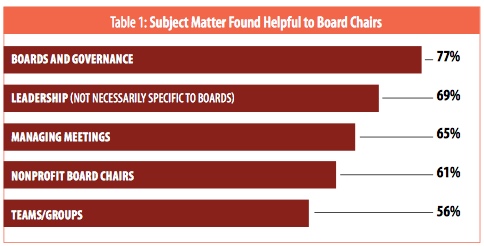
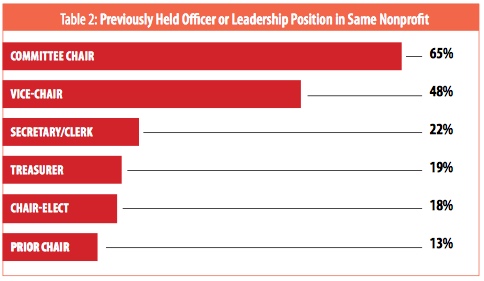
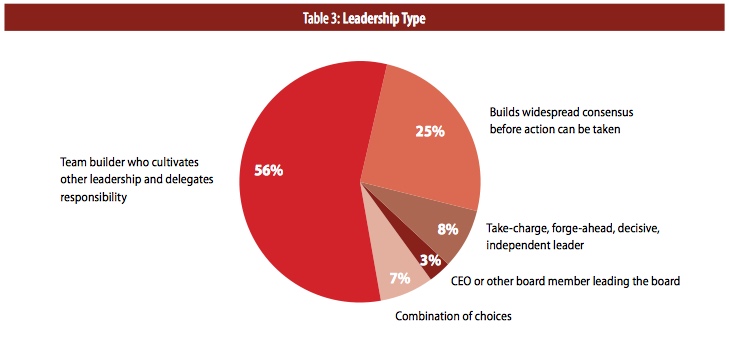
In the open-ended comments made in response to the above questions, board chairs referred most frequently to different types of experiences—rather than people or information—they found helpful in preparing to become board chair. For instance, 82 percent of the board chairs found that serving on a committee, in their current or a previous nonprofit, was a helpful preparatory experience.
In fact, this was a much more common experience for the responding board chairs than any board officer role. Fifty-two percent indicated that being a board chair in another nonprofit was a helpful preparatory experience.
The final question about preparation for becoming a board chair was: “In hindsight, what one resource, person, or experience would you like to have had to help you prepare to be a board chair?” The most common themes that emerged in response included: 1) mentoring; 2) peer networking; 3) training; and 4) access to a specific resource on demand.
Overall, the board chairs’ responses indicated interest and a willingness to learn. They tended to look to a colleague such as a former board chair and/or the CEO within their current organization for advice, and were not aware of—or chose not to use—a variety of resources external to their nonprofits that might be helpful to their role as chair.
Perceptions of the Board Chair Role
A second focus of the survey was board chairs’ perceptions of their role, specifically in relationship to the board, the CEO, and the community. These relationships align with Yvonne Harrison and Vic Murray’s three sets of relationships within which board chairs execute their leadership role in nonprofits: the chair in relation to the board; the chair in relation to the CEO; and the chair in relation to external stakeholders or the community.1
1. Chair Role in Relation to the Board
Primary Duties
Respondents were asked to identify what they perceived to be their top three duties as board chair in relation to the board. They selected the top three duties from a list of eleven commonly accepted board chair duties found in the practitioner literature.2 Duties ranking the highest included the following:
- Keep the board’s focus on the organization’s strategic direction: 64 percent.
- Ensure the board fulfills its governance responsibilities: 49 percent.
- Preside over and manage board meetings: 42 percent.
Respondents, however, expressed their reluctance to choose three “top” duties, as they viewed their role with the board as both multifaceted and often situational.
Leadership Model
To further understand the board chairs’ understanding of their role, the survey also solicited perceptions about the board chairs’ style of leadership. The research team hypothesized that the style of leadership may affect perceptions regarding role. With this premise in mind, the survey asked respondents to select the type of leader they perceived themselves to be from a list of four options. A little over half of the respondents felt that they were a “team builder who cultivates other leadership and delegates responsibility,” and only about a quarter of the respondents reported that they “build widespread consensus before action can be taken.”
About 8 percent of respondents described themselves as a “take-charge, forge-ahead, and decisive, independent leader.” Three percent of respondents stated that the CEO or another board member was actually leading the board. Seven percent chose “other” as a response, and a percentage of these respondents described themselves as a combination of the choices, depending on the situation.
Perceptions Regarding Leadership
Perceptions of the experience in leading as chair also matter when attempting to understand the chair-to-board relationship. The survey offered board chairs five choices to describe their feelings about leading the board. Chairs reported high degrees of feeling competent (87 percent), supported (81 percent), and confident (84 percent). Seventy percent reported sometimes feeling frustrated, and only 34 percent sometimes felt isolated. (See Table 4.)
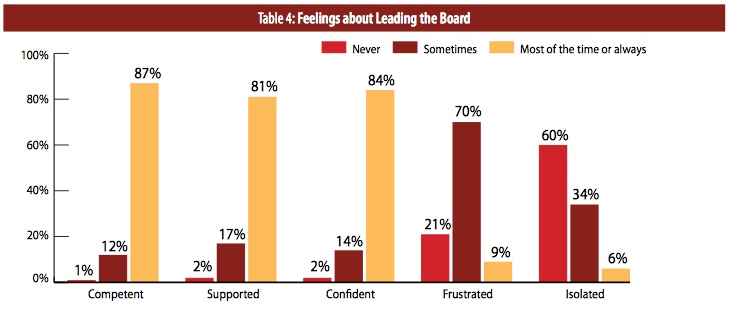
Leadership Practice
An additional insight about the role of the chair in relation to the board is provided by understanding the process for constructing board meeting agendas. When the respondents were asked who was the most responsible for developing board meeting agendas, 42 percent indicated that they developed agendas in collaboration with their CEO, 16 percent indicated that the CEO developed the agenda, and 15 percent developed it alone. See further details in Table 5.
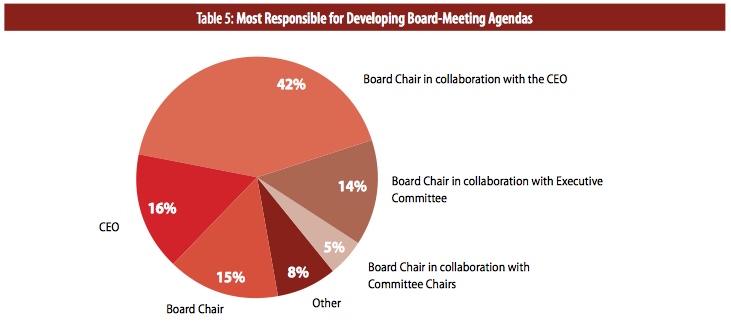
The comments regarding who was most responsible for developing board meeting agendas were nuances of the above. For example, some common responses included: “the agenda is created in the executive committee on which the CEO serves” or “the CEO draws up the agenda in collaboration with the board chair.”
2. Chair Role in Relation to the CEO
As stated earlier, a second perspective for understanding the role of the chair can be gained from understanding the board chair’s relationship to that of the CEO. Therefore, in the survey respondents were asked to describe the nature of their relationship with the CEO and the specific roles of each.
Nature of the Board Chair–CEO Relationship
When asked to describe what their relationship with the CEO was built on, respondents selected the following:
- Communication between meetings: 92 percent.
- Meeting obligations to one another: 90 percent.
- Mutual trust: 88 percent.
Specific Role in Relation to the CEO
Respondents also described what they perceived to be their role in relationship to the CEO. The survey offered a list of normative practices from which to choose. Chairs were asked to select “not applicable” if they did not feel an option was an appropriate role for a board chair. The highest ranking roles in the board chairs’ relationship to their CEO (cited as “most” or “all of the time”) were: as a leadership partner (73 percent) and as the CEO’s sounding board (58 percent).
A majority of chairs (81 percent) identified themselves as at least “sometimes” serving as a consultant to the CEO on operational issues; almost a third (30 percent) of the chairs selected the option “most of the time” or “always”; 77 percent identified themselves as supervising their CEO at least some of the time, with 46 percent of that group finding themselves in that role “most of the time” or “always.” Table 6 provides additional responses.
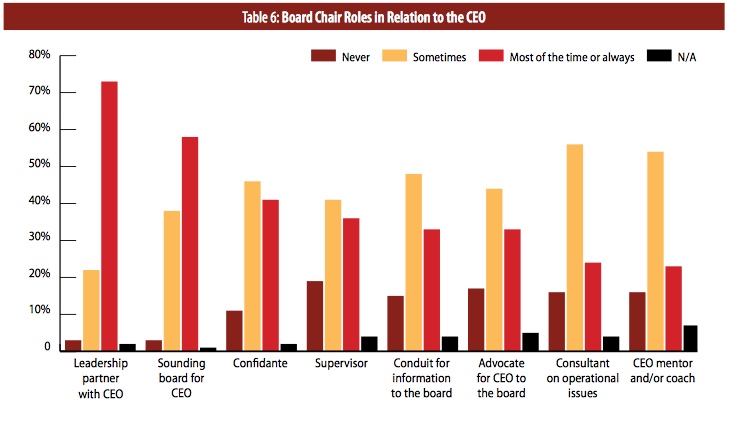
As another reference point to understand the chair–CEO relationship, chairs were asked to describe their “power relationship.” Sixty-three percent described the CEO and chair as equally strong, with 19 percent stating that they had a strong CEO and a weak board. Many of the comments on this question indicated some transitions in the relationship or that the chair was currently working to strengthen the relationship.
3. Board Chair’s Leadership Role in Relationship to Stakeholders and the Community
The third relationship area explored was the role of the chair in relation to stakeholders and the community. Both the nonprofit research and practitioner sectors have been increasingly interested in encouraging boards to engage to a greater extent with external stakeholders and the communities they serve, as well as to engage in advocacy and public policy.
Respondents reported that they were most engaged with the community by attending community events (49 percent “sometimes”; 42 percent “frequently”), and promoting involvement of constituents (39 percent “sometimes” and 45 percent “frequently”). The findings, however, were unclear regarding how survey participants understood the meaning of “promoting involvement by constituents with their organization.” Only 18 percent indicated that they frequently engaged in advocacy or interacted with other boards, and 12 percent indicated that they “frequently” spoke to the media. Thirty percent of respondents indicated that they “frequently” met with current or potential donors, while a little over half (55 percent) of the respondents reported that they “sometimes” met with current and potential donors. (See further details in Table 7.)
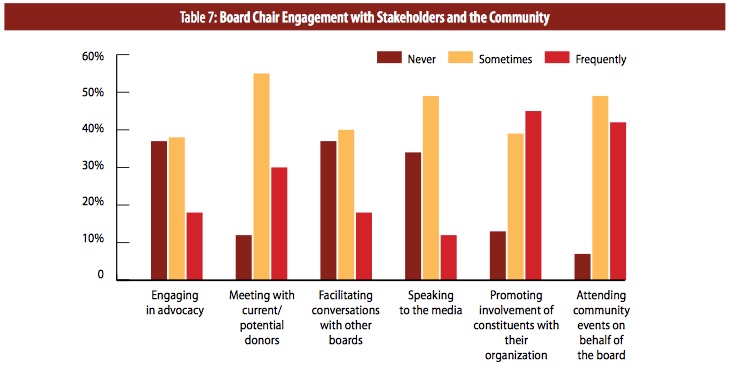
Sign up for our free newsletters
Subscribe to NPQ's newsletters to have our top stories delivered directly to your inbox.
By signing up, you agree to our privacy policy and terms of use, and to receive messages from NPQ and our partners.
4. Coleadership among CEOs or Board Chairs
Most boards follow traditional practices in which one board member, individually, assumes the leadership role of the board chair. While there is increasing discussion within the sector that the solo leadership role of the board chair is onerous and that a coleadership or shared leadership model might lead to more effective governance, there has been little experimentation or research in this area. For this reason, the survey asked about cochair and other shared leadership models. The responses revealed that only 6 percent of the chairs described themselves as cochairs. As a way to understand the leadership culture in their organizations, the respondents were also asked to describe shared leadership models within their staff. Only 8 percent of the respondents reported that their organizations had coexecutive leadership; the highest percentages reporting this were from arts, culture, and humanities organizations (15 percent) and environmental organizations (14 percent).
Descriptive Board Chair and CEO Information
Three sets of questions were asked to gain demographic understanding about respondents and their organizations. The first set focused on gathering information about the respondents, and the second set focused on gaining some insights about the CEOs. The third set—focused on the demographics of the respondents’ organizations—is not included in this article.
The Board Chairs
What types of experiences did survey respondents bring to the board in their new leadership position? What types of nonprofits, in what organizational life stages, were they called to govern? Several survey questions offer details that help to answer those contextual questions.
Tenure as Board Chair
Length of service in their current board chair position ranged from “less than one year” to “more than five years.” Survey participants selecting “more than five years” were asked to offer a more specific response; responses ranged from six to twenty-five years. As the following table shows, a majority (63 percent) had served as board chair for only two years or less.
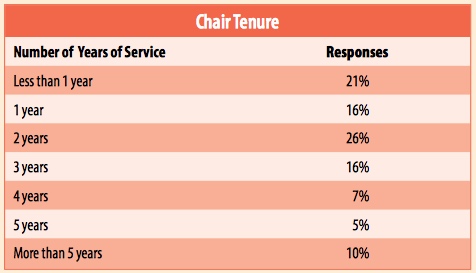
Time Served on the Current Board
Respondents were asked how long they had served on the current board prior to accepting the chair position. Just over half (55 percent) had been on their boards three years or less before becoming board chair, and almost a sixth served on their board less than a year before becoming board chair.
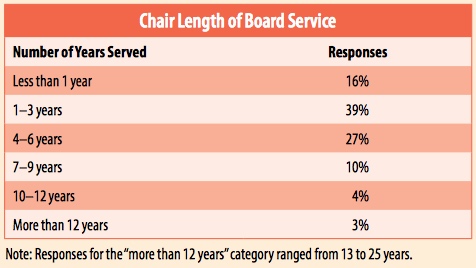
Years Served
Respondents were asked about years served in one of six common board leadership positions: vice-chair, treasurer, secretary/clerk, chair (served prior to current period), chair-elect, and committee chair. As the following table demonstrates, serving as committee chair was the most common.
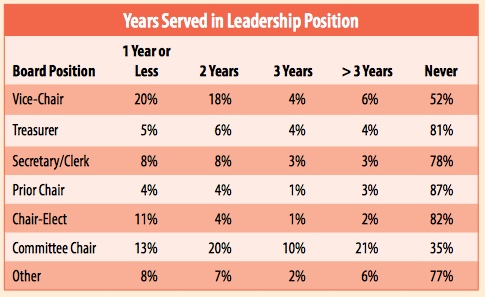
Total Years of Board Service
Survey respondents were asked about their cumulative nonprofit governance experience—the total number of years served on any nonprofit board. Respondents chose from one of six ranges, from “three or fewer years” to “more than fifteen years.”
Those choosing more than fifteen years were encouraged to offer a more specific number of years. The highest was sixty years. A correlation between the response here and the respondent’s age would be expected. However, the survey did not include a question regarding the latter.

The Nonprofit CEOs
The survey also included questions requesting general information about the presence of, and the circumstances surrounding, the chief executive officers within the respondents’ organizations.
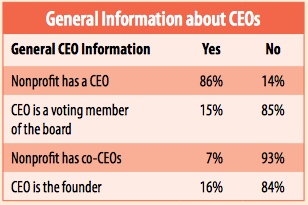
Length of Time CEO in Current Position
Finally, board chair respondents were asked to identify the length of time that their current CEO—or last CEO, if the organization was in leadership transition—had been in the position. The findings revealed a relatively even distribution of tenure lengths for the CEO, from only one to two years to more than twelve years.
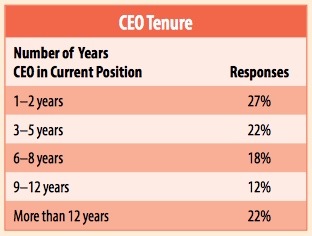
Governance Practice Implications and Recommendations
This research was conducted to increase understanding of nonprofit board chairs, their preparation, and their perception about their roles, as a platform to inform nonprofit and capacity-building practices. Although it was not the intent of this study to link board chair preparation and/or the understanding of board roles to board or organizational effectiveness, the findings provide important practice implications and recommendations for the sector, described below.
1. Establish an intentional, well-developed practice of board chair preparation and succession planning.
It was of concern that 51 percent of the board chair respondents indicated that they did nothing special to prepare for being a board chair. Moreover, 16 percent of board chairs reported that they had only served on their board less than a year, and 56 percent reported that they had only served on their board three years or less before becoming chair, therefore providing very little time for preparation for such a key leadership role. While most respondents indicated some type of intentional consideration when asked how they came to be board chair, an interesting theme emerged from the qualitative responses: the movement of individuals into the board chair role as a result of unexpected events. These events included the unanticipated resignation of the chair, and the inability of candidates designated as next in line to serve because of work, health, or family demands. Some chairs noted that their progression into the role was based on simply being available, or willing to serve because others were unwilling. An intentional, well-planned practice of grooming and selection, which includes leadership development for new board chairs, may facilitate more successful transitions and effective board leadership, as well as a deeper bench of leadership.
2. Clarify the role of the chair in relationship to the full board, the CEO, and the organization’s community, so that there is shared agreement within the board.
The data indicated a variety of perceptions among respondents of the board chair’s role. With organizations of many sizes and stages of development, and in response to differing community conditions, boards will benefit from greater clarity and shared agreement on what role their board chair should be playing, rather than letting each chair define that role for him- or herself. This recommendation is also based on the findings from Harrison and Murray’s research.3 Once defined, it is important to communicate that role clearly among the board and staff. And of course, research data can help inform those role definitions.
3. Provide training, mentoring, and coaching opportunities specifically for board chairs.
The data demonstrate that a high percentage of board chairs in the study do not engage in training, mentoring, or coaching to help them adapt to their new position or to increase their effectiveness. But mentoring, training, and peer networking were identified as the primary resources they would like to have had to help them prepare.
Harrison and Murray’s study on perceived characteristics of effective versus ineffective chairs identified skills and practices that can be learned either through education, mentoring, or coaching.4 Some of those include: 1) facilitation skills; 2) team development skills/how to build board cohesion; 3) collaboration skills; 4) dealing with conflict; 5) how to build motivation; 6) developing a working partnership with the CEO; and 7) how to provide vision and direction. Capacity-building initiatives and consulting assistance that facilitate one-to-one mentoring—or coaching for board chairs and for emerging governance focused on such skills—would offer critical and useful leadership development for board chairs. Additionally, peer-learning initiatives for board chairs and prospective chairs would provide useful forums for board chair learning and preparation.
A significant number of respondents communicated that observing or getting advice from prior board chairs or friends who had been board chairs was helpful. More questions than answers arise from this finding. What is unknown is precisely what benefits were being drawn from these observations and advice. What exactly were the board chairs learning from the previous board chairs? And, given that former chairs were identified as important role models, what was the consequence when those chairs did not perform effectively? Does this method of modeling just create repetitive cycles with generations of ineffective chairs, thereby perpetuating poor leadership? These are significant questions for future research.
4. Build leadership capacity for many potential board leaders, including committee chairs.
Responses indicated that the most frequently held leadership position prior to becoming the board chair was that of a committee chair—even more frequent than any other officer role. Moreover, 82 percent of the respondents cited their experience as committee chair as important in helping them prepare for serving in the board chair position. The data suggest that more attention needs to be given to preparing committee chairs for their leadership position, both as a committee chair and as a route to the board chair position. The preparation could include mentoring and skills-based training, such as how to design effective agendas, facilitate meetings, build consensus, and the like.
Intentional succession planning—which includes identifying potential leaders on the board at least a year in advance of their assuming the chair position—along with mentoring or other leadership training would provide new board chairs with the support needed for effective leadership. In addition, as suggested by the data, providing committee chair experience, coupled with leadership training, can be helpful in building a larger pool of potential effective leaders. The data suggest that in order to develop a deeper pool of potential leaders, not only would board chairs benefit from mentoring and training but also boards as a whole and committee chairs in particular would benefit from regular board leadership development training and coaching.
5. Provide more accessible and research-based resources for board chairs and capacity builders.
The data indicate that, in general, respondents did not access the Internet, workshops, or books or other written resources that could help prepare them for their role as board chair. While the data did not reveal why they were not accessing these resources, there may be a number of reasons. Perhaps they were overwhelmed with the enormous amount of online resources for boards, including articles, magazines, tools, blogs, and other social media, all purporting to be based in so-called “best practices.” Additionally, based on the research in preparation for this study, while there is indeed a plethora of prescriptive literature, there are few resources that specifically target board chairs or capacity builders who help support chairs—and even fewer that are based on research or evidence. Even if these resources were available, it is uncertain whether board chairs would access them. Readily accessible, research-based practice tools and resources specifically intended for board chair development could make a significant positive impact.
6. Support the board chair leadership function to improve both the chair’s and the board’s involvement in community engagement and advocacy.
Although it is increasingly accepted in the nonprofit sector that the board’s external advocacy and community engagement role is an important responsibility, the data indicate that board chairs do not generally engage externally with the community, media, funders, other boards, or stakeholders. The data also may suggest that board chairs did not view community engagement as an important part of their role.
In alignment with a 2015 BoardSource study, Leading With Intent, board chairs indicated a generally low frequency of engagement with the community.5 Of particular note is the very low percentage of those who engaged in advocacy, spoke to the media, and met with current and potential donors on a frequent basis. Only 18 percent of respondents indicated that they frequently engaged in advocacy or interacted with other boards; only 29 percent frequently met with current or potential donors; and only 12 percent indicated that they frequently spoke to the media. The survey, however, did not delve into the “why” behind these responses; therefore, it is not clear from the data if the responses indicate that the board chairs did not feel that these responsibilities were part of their or the board’s role, or that they did not have the knowledge and/or training to engage with their community, funders, and other stakeholders.
Although a higher percentage of board chairs (45 percent) indicated that they frequently promoted involvement by constituents in their organizations, it remains unclear how this question was understood. Did the chairs understand this to mean only engaging constituents to participate in program activities? Did it mean engaging them in occasional focus groups or surveys? Or did it mean engaging constituents in some level of governance or organizational decision making? Further research is needed to explore these questions.
As advocacy and community engagement are important governance functions, board chairs can serve in an important leadership role promoting the board’s external role in both advocacy and engaging the organization’s stakeholders. As part of their preparation recommended earlier in this report, board chairs would benefit from gaining critical leadership skills in advocacy, funder and donor cultivation, media relations, and community engagement. Capacity-building initiatives, which include coaching and mentoring, should incorporate these skills for both the board chair and emerging leaders within boards and their committees.
7. Consider moving from a “heroic” individual model of leadership to shared leadership.
Normative practice for nonprofit boards has been to have one primary leader, the chair, who generally holds much of the power and authority for leading the board. Is the widely practiced individual model of leadership the most effective one? Are the leadership responsibilities for board chairs unrealistic for one person to execute effectively? Or, would a shared leadership structure provide a more useful model for boards? Growing research in this area has demonstrated the relationship between shared leadership and a positive impact on team performance outcomes that may have implications for board functioning.6 In addition to increased positive outcomes, another benefit of shared leadership models is that they provide a more intentional way to build leadership skills and experience beyond the single chair, thereby developing a wider pool of leaders for boards.
There are different models of shared leadership that boards could consider adopting, including: 1) cochairs who divide up the leadership responsibilities; 2) multiple leaders within boards who share different aspects of the leadership responsibilities; 3) expanding executive committees beyond officers in order to distribute coordinating responsibilities; and 4) disbanding executive committees while distributing leadership among multiple board members.
…
These findings are intended to contribute to the limited body of research on board chairs and to a greater understanding of board leadership. We believe these findings and practice implications can encourage boards to place a greater emphasis on intentional board chair preparation and succession planning, as well as strengthen board leadership.
We hope that these findings will encourage more research in the critical area of board leadership and expand the possibility for shared leadership. Future research in this area will help boards and board chairs have greater access to research-based practices, ultimately improving the effectiveness of nonprofit governance.
Notes
- Yvonne Harrison and Vic Murray, “Perspectives on the leadership of chairs of nonprofit organization boards of directors: A grounded theory mixed-method study,” Nonprofit Management & Leadership 22, no. 4 (Summer 2012): 411–37.
- Mindy R. Wertheimer, The Board Chair Handbook, 3rd ed. (Washington, DC: BoardSource, 2013).
- Harrison and Murray, “Perspectives on the leadership of chairs of nonprofit organization boards of directors.”
- Ibid.
- BoardSource, Leading With Intent: A National Index of Nonprofit Board Practices (Washington, DC: BoardSource, 2015).
- Vias C. Nicolaides et al., “The shared leaders of teams: A meta-analysis of proximal, distal, and moderating relationships,” Leadership Quarterly 25, no. 5 (October 2014): 923–42.











